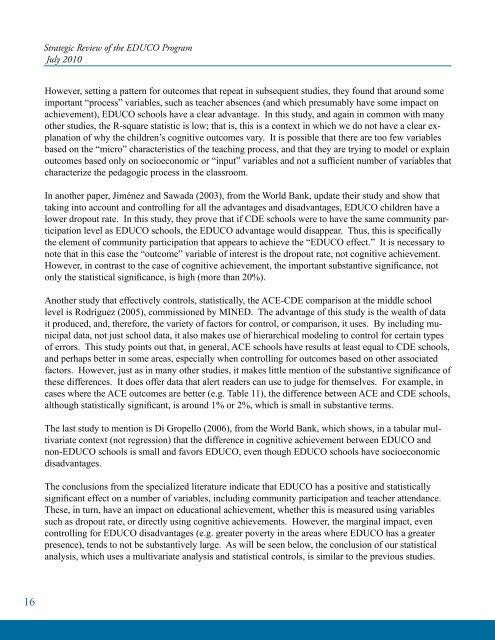Strategic Review of the EDUCO Program - EQUIP123.net
Strategic Review of the EDUCO Program - EQUIP123.net
Strategic Review of the EDUCO Program - EQUIP123.net
Create successful ePaper yourself
Turn your PDF publications into a flip-book with our unique Google optimized e-Paper software.
<strong>Strategic</strong> <strong>Review</strong> <strong>of</strong> <strong>the</strong> <strong>EDUCO</strong> <strong>Program</strong>July 2010However, setting a pattern for outcomes that repeat in subsequent studies, <strong>the</strong>y found that around someimportant “process” variables, such as teacher absences (and which presumably have some impact onachievement), <strong>EDUCO</strong> schools have a clear advantage. In this study, and again in common with manyo<strong>the</strong>r studies, <strong>the</strong> R-square statistic is low; that is, this is a context in which we do not have a clear explanation<strong>of</strong> why <strong>the</strong> children’s cognitive outcomes vary. It is possible that <strong>the</strong>re are too few variablesbased on <strong>the</strong> “micro” characteristics <strong>of</strong> <strong>the</strong> teaching process, and that <strong>the</strong>y are trying to model or explainoutcomes based only on socioeconomic or “input” variables and not a sufficient number <strong>of</strong> variables thatcharacterize <strong>the</strong> pedagogic process in <strong>the</strong> classroom.In ano<strong>the</strong>r paper, Jiménez and Sawada (2003), from <strong>the</strong> World Bank, update <strong>the</strong>ir study and show thattaking into account and controlling for all <strong>the</strong> advantages and disadvantages, <strong>EDUCO</strong> children have alower dropout rate. In this study, <strong>the</strong>y prove that if CDE schools were to have <strong>the</strong> same community participationlevel as <strong>EDUCO</strong> schools, <strong>the</strong> <strong>EDUCO</strong> advantage would disappear. Thus, this is specifically<strong>the</strong> element <strong>of</strong> community participation that appears to achieve <strong>the</strong> “<strong>EDUCO</strong> effect.” It is necessary tonote that in this case <strong>the</strong> “outcome” variable <strong>of</strong> interest is <strong>the</strong> dropout rate, not cognitive achievement.However, in contrast to <strong>the</strong> case <strong>of</strong> cognitive achievement, <strong>the</strong> important substantive significance, notonly <strong>the</strong> statistical significance, is high (more than 20%).Ano<strong>the</strong>r study that effectively controls, statistically, <strong>the</strong> ACE-CDE comparison at <strong>the</strong> middle schoollevel is Rodríguez (2005), commissioned by MINED. The advantage <strong>of</strong> this study is <strong>the</strong> wealth <strong>of</strong> datait produced, and, <strong>the</strong>refore, <strong>the</strong> variety <strong>of</strong> factors for control, or comparison, it uses. By including municipaldata, not just school data, it also makes use <strong>of</strong> hierarchical modeling to control for certain types<strong>of</strong> errors. This study points out that, in general, ACE schools have results at least equal to CDE schools,and perhaps better in some areas, especially when controlling for outcomes based on o<strong>the</strong>r associatedfactors. However, just as in many o<strong>the</strong>r studies, it makes little mention <strong>of</strong> <strong>the</strong> substantive significance <strong>of</strong><strong>the</strong>se differences. It does <strong>of</strong>fer data that alert readers can use to judge for <strong>the</strong>mselves. For example, incases where <strong>the</strong> ACE outcomes are better (e.g. Table 11), <strong>the</strong> difference between ACE and CDE schools,although statistically significant, is around 1% or 2%, which is small in substantive terms.The last study to mention is Di Gropello (2006), from <strong>the</strong> World Bank, which shows, in a tabular multivariatecontext (not regression) that <strong>the</strong> difference in cognitive achievement between <strong>EDUCO</strong> andnon-<strong>EDUCO</strong> schools is small and favors <strong>EDUCO</strong>, even though <strong>EDUCO</strong> schools have socioeconomicdisadvantages.The conclusions from <strong>the</strong> specialized literature indicate that <strong>EDUCO</strong> has a positive and statisticallysignificant effect on a number <strong>of</strong> variables, including community participation and teacher attendance.These, in turn, have an impact on educational achievement, whe<strong>the</strong>r this is measured using variablessuch as dropout rate, or directly using cognitive achievements. However, <strong>the</strong> marginal impact, evencontrolling for <strong>EDUCO</strong> disadvantages (e.g. greater poverty in <strong>the</strong> areas where <strong>EDUCO</strong> has a greaterpresence), tends to not be substantively large. As will be seen below, <strong>the</strong> conclusion <strong>of</strong> our statisticalanalysis, which uses a multivariate analysis and statistical controls, is similar to <strong>the</strong> previous studies.16

















